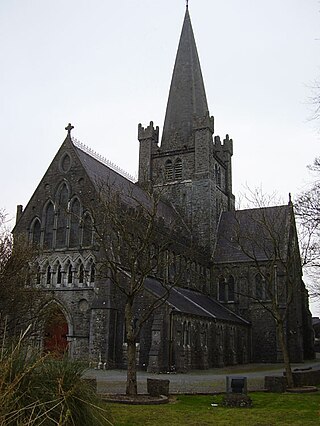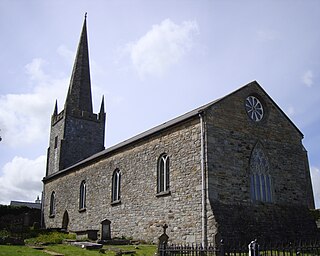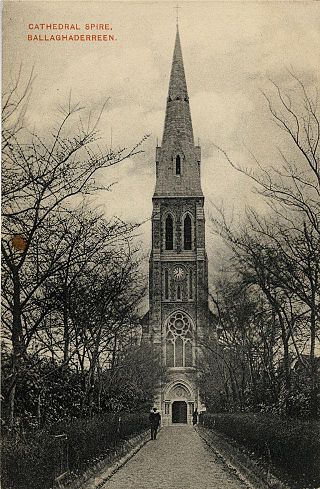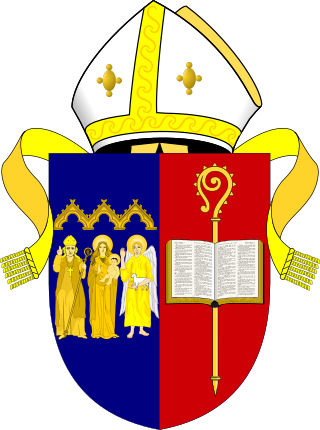
The Archbishop of Tuam is an archbishop which takes its name after the town of Tuam in County Galway, Ireland. The title was used by the Church of Ireland until 1839, and is still in use by the Catholic Church.

The Bishop of Killala is an episcopal title which takes its name after the village of Killala in County Mayo, Ireland. In the Roman Catholic Church it remains a separate title, but in the Church of Ireland it has been united with other bishoprics.

The Archdiocese of Tuam is an Latin Church ecclesiastical territory or archdiocese of the Catholic Church located in western Ireland. The archdiocese is led by the Archbishop of Tuam, who serves as pastor of the mother church, the Cathedral of the Assumption and Metropolitan of the Metropolitan Province of Tuam. According to tradition, the "Diocese of Tuam" was established in the 6th century by St. Jarlath. The ecclesiastical province, roughly co-extensive with the secular province of Connacht, was created in 1152 by the Synod of Kells.

The Diocese of Achonry is a Latin Church diocese of the Catholic Church in the western part of Ireland. It is one of the five suffragan sees of the Archdiocese of Tuam. The diocese was often called the "bishopric of Luighne" in the Irish annals. It was not established at the Synod of Rathbreasail, but Máel Ruanaid Ua Ruadáin signed as "bishop of Luighne" at the Synod of Kells.

The Diocese of Killala is a Latin Church diocese of the Catholic Church in Connacht; the western province of Ireland. It is in the Metropolitan Province of Tuam and is subject to the Metropolitan Archdiocese of Tuam. As of 2023, the bishop is Dr. John Fleming DD who was appointed on 7 April 2002.
The Bishop of Achonry is an episcopal title which takes its name after the village of Achonry in County Sligo, Ireland. In the Roman Catholic Church it remains as a separate title, but in the Church of Ireland it has been united with other bishoprics.
The Archbishopric of Tuam existed from the mid twelfth century until 1839, with its seat at Tuam.

The Diocese of Tuam, Killala and Achonry is a former diocese in the Church of Ireland located in Connacht; the western province of Ireland. It was in the ecclesiastical province of Armagh. Its geographical remit included County Mayo and part of counties Galway and Sligo. In 2022, the diocese was amalgamated into the Diocese of Tuam, Limerick and Killaloe.

The Bishop of Tuam, Killala and Achonry is the Church of Ireland Ordinary of the united Diocese of Tuam, Killala and Achonry in the Province of Armagh. The present incumbent is the Right Reverend Patrick Rooke.
Diocese of Killala may refer to:
The Bishop of Annaghdown is an episcopal title which takes its name after the small village of Annaghdown in County Galway, Republic of Ireland.
The Bishop of Mayo was an episcopal title which took its name after the village of Mayo in Ireland. After the Reformation, the title was briefly used by the Church of Ireland until 1559 and by the Roman Catholic Church until 1631. With each denomination, the bishopric was united to the archbishopric of Tuam.
Philip Phillips was an Irish clergyman of the Roman Catholic Church. He served as Archbishop of Tuam from 1785 to 1787.
The Dean of Tuam is a post held in the Diocese of Tuam, as head of the cathedral chapter from after the creation of the diocese at the Synod of Rathbreasail in 1111.

The Dean of Killala is based at the Cathedral Church of St Patrick, Killala in the Diocese of Killala within the united bishopric of Tuam, Killala and Achonry of the Church of Ireland. The Cathedral Church of St Crumnathy, Achonry, was closed in 1997. The Chapters of Killala & Achonry were amalgamated in 2013; The Cathedral of St Patrick, Killala, becoming also the diocesan Cathedral of Achonry. The Dean of Killala is the Very Revd Alistair Grimason, also Dean of Tuam.

The Dean of Achonry used to be based at the Cathedral Church of St Crumnathy, Achonry in the Diocese of Achonry within the united bishopric of Tuam, Killala and Achonry of the Church of Ireland.
Edward Synge, D.D., M.A., B.A. (1659–1741) was an Anglican clergyman who served in the Church of Ireland as Chancellor of St Patrick's Cathedral, Dublin (1705–1714), Bishop of Raphoe (1714–1716), and Archbishop of Tuam (1716–1741).

St Patrick's Cathedral, Killala is one of five cathedral churches in the Diocese of Tuam, Limerick and Killaloe of the Church of Ireland. It is situated on the Ballina to Ballycastle road in the small coastal village of Killala, County Mayo, Ireland. It is part of the ecclesiastical province of Dublin.

St. Crumnathy's Cathedral Achonry, is a former cathedral in the Republic of Ireland.

The Diocese of Tuam, Limerick and Killaloe is a diocese of the Church of Ireland that is located in the west of Ireland. The diocese was formed by a merger of the former Diocese of Tuam, Killala and Achonry and the former Diocese of Limerick and Killaloe in 2022, after the retirement of the separate dioceses' bishops and the appointment of Michael Burrows as bishop of the united diocese. It is in the ecclesiastical province of Dublin. It is one of the eleven Church of Ireland dioceses that cover the whole of Ireland. The largest diocese by area in the Church of Ireland, it covers all of counties Clare, Galway, Kerry, Limerick and Mayo, plus parts of counties Cork, Sligo, Roscommon, Offaly, Laois and Tipperary.







